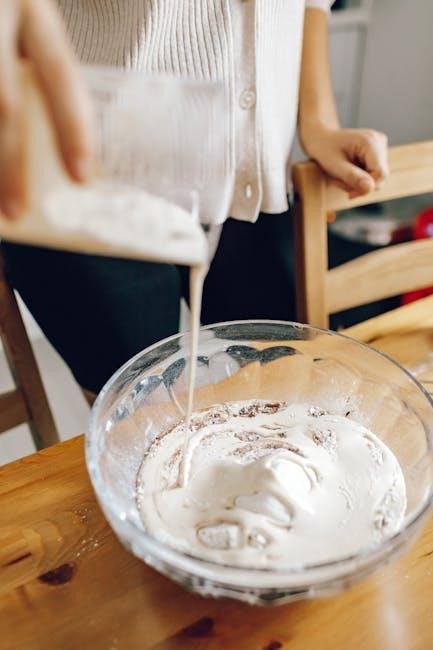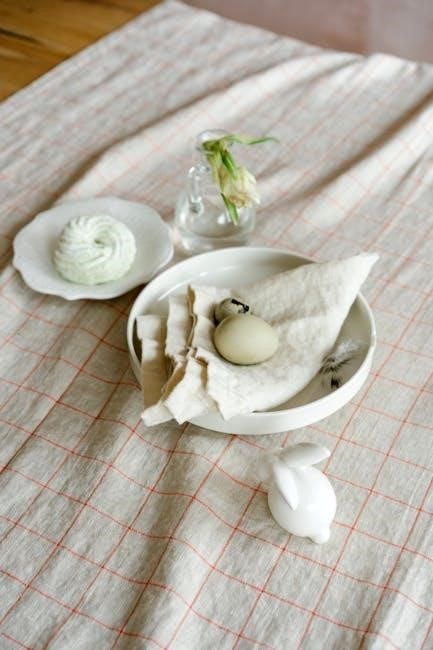Purina Calf Milk Replacer is a premium, nutrient-rich formula designed to support optimal growth and health in calves. It provides essential protein, fat, and prebiotics for muscle development, immune health, and digestive well-being. Trusted by dairy farmers, this complete and balanced formula ensures calves receive the nutrients needed for strong development and long-term productivity.
1.1 What is Purina Calf Milk Replacer?
Purina Calf Milk Replacer is a high-quality, nutrient-rich formula specifically designed to meet the dietary needs of calves. It is a complete and balanced milk replacer that provides essential protein, fat, and prebiotics to support healthy growth and development. Formulated with advanced nutrition, it helps promote immune health, digestive well-being, and optimal muscle development in calves. This product is trusted by dairy farmers and calf raisers for its ability to deliver consistent results and support long-term productivity;
1.2 Importance of Proper Mixing and Feeding
Proper mixing and feeding of Purina Calf Milk Replacer are critical for ensuring calves receive the right balance of nutrients. Incorrect mixing can lead to health issues, such as dehydration or digestive problems. Feeding at the recommended rate supports optimal growth, immune health, and muscle development. Accurate preparation ensures the powder dissolves fully, delivering essential vitamins, minerals, and prebiotics. Proper hydration and nutrient intake are vital for calves to thrive, making precise mixing and feeding practices indispensable for their overall well-being and long-term productivity.
Step-by-Step Mixing Instructions
Begin by adding water, then slowly incorporate Purina Calf Milk Replacer powder, stirring thoroughly. Adjust water to achieve the desired consistency and volume. Feed at 1.5 lbs daily.
2.1 Materials Needed for Mixing
To mix Purina Calf Milk Replacer, you’ll need clean water, a sturdy mixing bucket, and a measuring cup or scale. A whisk or electric mixer ensures smooth blending. Always use a clean feeding bucket or bottle for calves. Store the powder in its original bag or a sealed container to maintain freshness. Ensure all equipment is sanitized before and after use to prevent contamination and promote calf health.
2.2 Correct Water Temperature for Mixing
Use clean, lukewarm water at 100°F to 110°F for mixing Purina Calf Milk Replacer. Avoid hot water, as it can damage the nutrients. Start by adding water to the mixing container, then gradually incorporate the powder. Stir thoroughly until smooth. Ensure no lumps remain, as uneven mixing can affect calf health. Always test the temperature with your hand before feeding to prevent discomfort. Proper temperature ensures optimal nutrient absorption and maintains calf comfort during feeding.
2.3 Measuring the Powder Accurately
Accurate measurement is critical for proper mixing. Use a clean, dry scoop to measure 1.5 lbs of Purina Calf Milk Replacer powder per gallon of water. Ensure the powder is leveled off to avoid over- or under-feeding. For larger batches, use a scale to maintain precision. Avoid packing the powder, as this can lead to an incorrect ratio. Proper measurement ensures the correct nutrient balance, promoting healthy growth and digestion in calves. Always refer to the product label for specific guidelines.
2.4 Mixing Process: Powder to Water Ratio
Mixing Purina Calf Milk Replacer requires a precise ratio of 1.5 lbs of powder to 1 gallon of water. Start by adding the measured powder to a small amount of water, stirring until dissolved. Gradually add the remaining water, mixing thoroughly to prevent lumps. Ensure the solution reaches the correct volume and consistency. Proper mixing avoids nutritional imbalances, ensuring calves receive the right amount of protein, fat, and other nutrients for optimal growth and health. Always mix in clean, sanitized equipment to maintain hygiene and safety.
Feeding Guidelines and Rates

Feed calves at a rate of 1.5 lbs per day, ensuring proper nutrition for growth and health. Adjust based on age, weight, and environmental conditions to optimize development.
3.1 Recommended Daily Feeding Rate
The recommended daily feeding rate for Purina Calf Milk Replacer is 1.5 lbs per calf, ensuring proper nutrition for growth and health. This rate supports optimal development, providing essential nutrients like protein and fat. Adjustments may be needed based on factors such as age, weight, and environmental conditions to ensure calves receive the right amount for their specific needs. Proper feeding rates help promote strong growth, immune health, and overall well-being in calves.
3.2 Adjusting Feed Rates Based on Calf Age and Weight
Feed rates for Purina Calf Milk Replacer should be adjusted based on calf age and weight to meet their nutritional needs. Younger calves may require more frequent, smaller feedings, while older calves can handle larger amounts. As calves grow, gradually transition from milk replacer to starter feeds. Monitoring weight gain and muscle development helps determine if adjustments are needed. Proper adjustments ensure optimal growth, immune support, and digestive health, tailored to the calf’s specific developmental stage and size.
3.4 Feeding Frequency and Schedule
Calves should be fed Purina Calf Milk Replacer 2-3 times daily, depending on age and development stage. Newborn calves benefit from feeding at consistent intervals, such as mornings and evenings, to mimic natural feeding patterns. As calves grow, gradually reduce the frequency while increasing the amount per feeding. Maintaining a consistent schedule supports digestive health and ensures steady nutrient intake, promoting overall growth and well-being. Adjustments should align with the calf’s energy needs and weight gain progress.

Product Formulation and Nutritional Profile
Purina Calf Milk Replacer is a balanced formula with 22% protein and 20% fat, ensuring optimal growth. It includes essential vitamins, minerals, and prebiotics for digestive health and immune support.
4.1 Protein and Fat Content
Purina Calf Milk Replacer contains 22% protein and 20% fat, providing essential nutrients for optimal growth. The balanced protein-to-fat ratio supports muscle development and energy needs. High-quality milk proteins promote efficient nutrient absorption, while the fat content ensures calves receive sufficient energy for daily activities and growth. This formulation helps calves develop strong frames and supports overall health, making it a reliable choice for dairy farmers aiming to raise healthy, productive animals.
4.2 Added Vitamins and Minerals
Purina Calf Milk Replacer is enriched with essential vitamins and minerals to support immune health and overall development. Added vitamins, such as Vitamin E, help protect calves from oxidative stress, while minerals like calcium and phosphorus promote strong bone growth. The balanced blend ensures calves receive the necessary nutrients for optimal health, supporting their immune system and energy needs during critical growth stages.
4.3 Prebiotics for Digestive Health
Purina Calf Milk Replacer contains prebiotics, which support a healthy digestive system in calves. These prebiotics help promote beneficial gut bacteria, improving nutrient absorption and reducing digestive issues. By fostering a balanced gut microbiome, they enhance overall health and support immune function. This feature is especially important for young calves, ensuring proper digestion and utilization of nutrients for optimal growth and development during critical early stages of life.
Health and Developmental Benefits
Purina Calf Milk Replacer supports immune health and muscle growth in calves. Its complete formula ensures strong development, promoting optimal growth, vitality, and productivity in young calves.
5.1 Supporting Immune Health in Calves
Purina Calf Milk Replacer contains essential nutrients and additives that support immune health in calves. Added vitamins and minerals help strengthen the immune system, reducing illness risks. Prebiotics promote a healthy gut, which is vital for immune function. This balanced formula ensures calves receive the necessary support for optimal immune development, especially during critical growth stages. Proper immune health helps calves thrive and resist infections, ensuring a strong foundation for long-term productivity and overall well-being.
5.2 Promoting Optimal Growth and Muscle Development
Purina Calf Milk Replacer is formulated to promote optimal growth and muscle development in calves. With a balanced blend of 22% protein and 20% fat, it provides the necessary energy and nutrients for muscle growth. The formula supports calves in reaching their full potential, ensuring proper frame and muscle development. By meeting the nutritional needs of calves, Purina Calf Milk Replacer helps achieve consistent growth rates and supports overall development, preparing calves for long-term productivity and success.

Tips for Successful Mixing and Feeding
Ensure accurate mixing by using 1.5 lbs of powder per gallon of water. Avoid over- or under-mixing to maintain proper hydration levels and nutrient balance. Always use fresh, clean water and store the powder in a dry, cool place. Check the mixing ratio on the label and adjust as needed for age and weight. Proper preparation ensures optimal nutrition and healthy calf development.
6.1 Avoiding Common Mixing Mistakes
Common mixing errors include incorrect water temperature, over- or under-mixing, and improper powder measurement. Use clean, fresh water at 110-120°F for optimal solubility. Measure powder accurately to avoid nutrient imbalances. Avoid mixing more than needed, as leftover solution can spoil. Ensure the powder dissolves fully to prevent caking. Always follow the label instructions for the correct powder-to-water ratio. Proper mixing prevents digestive issues and ensures calves receive the intended nutritional benefits. Consistency is key for healthy calf development.
6.2 Ensuring Proper Hydration Levels
Proper hydration is crucial for calf health. Mix Purina Calf Milk Replacer at the recommended ratio to avoid over-dilution, which can lead to inadequate nutrition. Use clean, fresh water at the correct temperature (110-120°F) for optimal mixing. Ensure calves have access to fresh water alongside their feeding schedule. Monitor for signs of dehydration, such as dry mouth or lethargy, and adjust feeding rates if necessary. Proper hydration supports digestive health and overall development, ensuring calves thrive from an early age.

Storage and Handling Instructions
Store Purina Calf Milk Replacer in a cool, dry place to maintain quality. Keep away from moisture and direct sunlight. Shelf life is up to 12 months. Always use the oldest stock first to prevent waste and ensure freshness.
7.1 Proper Storage Conditions
Purina Calf Milk Replacer should be stored in a cool, dry place, away from direct sunlight and moisture. Ensure the storage area is well-ventilated and free from pests. Avoid extreme temperatures, as they can affect the product’s quality. Keep the container tightly sealed after opening to prevent contamination. Always store the product in its original packaging to maintain freshness and nutritional integrity. Proper storage conditions help preserve the formula’s effectiveness and ensure optimal performance for calf nutrition.
7.2 Shelf Life and Expiry Considerations
Purina Calf Milk Replacer typically has a shelf life of 12 months from the manufacturing date when stored properly. Always check the expiration date on the packaging before use. For optimal quality, use the product within this period. Avoid using expired milk replacer, as it may lose nutritional potency and affect calf health. Store the product in a cool, dry place to maintain its freshness and ensure it remains effective until the expiry date.

Troubleshooting Common Issues
Common issues include clumping or uneven mixing. Ensure proper water temperature and powder measurement. Check for expired product or incorrect storage, which may affect performance and freshness.

8.1 Addressing Mixing Inconsistencies
Clumping or uneven mixing can occur due to incorrect water temperature or improper powder measurement. Ensure water is lukewarm (around 110°F) for optimal dissolution. If clumps form, stir thoroughly or re-mix with a small amount of warm water. Always use the recommended scoop size to measure powder accurately. Check expiration dates, as stale powder may not dissolve well. Avoid using expired product, as it can lead to mixing issues and reduced nutritional value for calves. Proper storage conditions are crucial to maintain product quality and mixing performance.
8.2 Managing Feeding Challenges in Calves
Feeding challenges may arise if calves are not consuming the milk replacer properly. Ensure the solution is mixed correctly to avoid digestive issues. Provide fresh water alongside to prevent dehydration.Monitor calves for signs of stress or refusal to feed, which may indicate a need to adjust feeding rates or schedules. Consult a veterinarian if persistent feeding problems occur. Consistency in feeding routines and maintaining a clean environment help promote healthy intake and overall calf well-being. Always adhere to the recommended feeding guidelines for optimal results.
